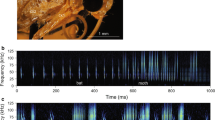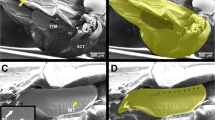Abstract
Assuming that bat-detection is the primary function of moth ears, the ears of moths that are no longer exposed to bats should be deaf to echolocation call frequencies. To test this, we compared the auditory threshold curves of 7 species of Venezuelan day-flying moths (Notodontidae: Dioptinae) to those of 12 sympatric species of nocturnal moths (Notodontidae: Dudusinae, Noctuidae and Arctiidae). Whereas 2 dioptines (Josia turgida, Zunacetha annulata) revealed normal ears, 2 (J. radians, J. gopala) had reduced hearing at bat-specific frequencies (20–80 kHz) and the remaining 3 (Thirmida discinota, Polypoetes circumfumata and Xenorma cytheris) revealed pronounced to complete levels of high-frequency deafness. Although the bat-deaf ears of dioptines could function in other purposes (e.g., social communication), the poor sensitivities of these species even at their best frequencies suggest that these moths represent a state of advanced auditory degeneration brought about by their diurnal life history. The phylogeny of the Notodontidae further suggests that this deafness is a derived (apomorphic) condition and not a retention of a primitive (pleisiomorphic), insensitive state.
Similar content being viewed by others
Author information
Authors and Affiliations
Additional information
Accepted: 1 May 1997
Rights and permissions
About this article
Cite this article
Fullard, J., Dawson, J., Otero, L. et al. Bat-deafness in day-flying moths (Lepidoptera, Notodontidae, Dioptinae). J Comp Physiol A 181, 477–483 (1997). https://doi.org/10.1007/s003590050131
Issue Date:
DOI: https://doi.org/10.1007/s003590050131




